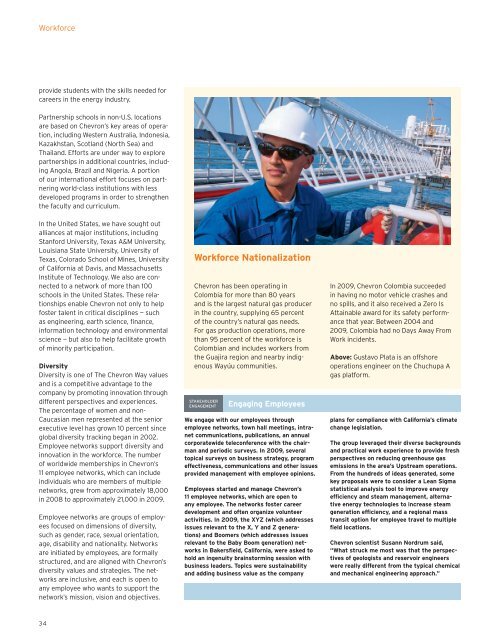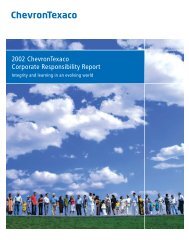Chevron Corporate Responsibility Report 2009
Chevron Corporate Responsibility Report 2009
Chevron Corporate Responsibility Report 2009
Create successful ePaper yourself
Turn your PDF publications into a flip-book with our unique Google optimized e-Paper software.
Workforce<br />
provide students with the skills needed for<br />
careers in the energy industry.<br />
Partnership schools in non-U.S. locations<br />
are based on <strong>Chevron</strong>’s key areas of operation,<br />
including Western Australia, Indonesia,<br />
Kazakhstan, Scotland (North Sea) and<br />
Thailand. Efforts are under way to explore<br />
partnerships in additional countries, including<br />
Angola, Brazil and Nigeria. A portion<br />
of our international effort focuses on partnering<br />
world-class institutions with less<br />
developed programs in order to strengthen<br />
the faculty and curriculum.<br />
In the United States, we have sought out<br />
alliances at major institutions, including<br />
Stanford University, Texas A&M University,<br />
Louisiana State University, University of<br />
Texas, Colorado School of Mines, University<br />
of California at Davis, and Massachusetts<br />
Institute of Technology. We also are connected<br />
to a network of more than 100<br />
schools in the United States. These relationships<br />
enable <strong>Chevron</strong> not only to help<br />
foster talent in critical disciplines — such<br />
as engineering, earth science, finance,<br />
information technology and environmental<br />
science — but also to help facilitate growth<br />
of minority participation.<br />
Diversity<br />
Diversity is one of The <strong>Chevron</strong> Way values<br />
and is a competitive advantage to the<br />
company by promoting innovation through<br />
different perspectives and experiences.<br />
The percentage of women and non-<br />
Caucasian men represented at the senior<br />
executive level has grown 10 percent since<br />
global diversity tracking began in 2002.<br />
Employee networks support diversity and<br />
innovation in the workforce. The number<br />
of worldwide memberships in <strong>Chevron</strong>’s<br />
11 employee networks, which can include<br />
individuals who are members of multiple<br />
networks, grew from approximately 18,000<br />
in 2008 to approximately 21,000 in <strong>2009</strong>.<br />
Employee networks are groups of employees<br />
focused on dimensions of diversity,<br />
such as gender, race, sexual orientation,<br />
age, disability and nationality. Networks<br />
are initiated by employees, are formally<br />
structured, and are aligned with <strong>Chevron</strong>’s<br />
diversity values and strategies. The networks<br />
are inclusive, and each is open to<br />
any employee who wants to support the<br />
network’s mission, vision and objectives.<br />
Workforce Nationalization<br />
<strong>Chevron</strong> has been operating in<br />
Colombia for more than 80 years<br />
and is the largest natural gas producer<br />
in the country, supplying 65 percent<br />
of the country’s natural gas needs.<br />
For gas production operations, more<br />
than 95 percent of the workforce is<br />
Colombian and includes workers from<br />
the Guajira region and nearby indigenous<br />
Wayúu communities.<br />
Stakeholder<br />
Engagement<br />
Engaging Employees<br />
We engage with our employees through<br />
employee networks, town hall meetings, intranet<br />
communications, publications, an annual<br />
corporatewide teleconference with the chairman<br />
and periodic surveys. In <strong>2009</strong>, several<br />
topical surveys on business strategy, program<br />
effectiveness, communications and other issues<br />
provided management with employee opinions.<br />
Employees started and manage <strong>Chevron</strong>’s<br />
11 employee networks, which are open to<br />
any employee. The networks foster career<br />
development and often organize volunteer<br />
activities. In <strong>2009</strong>, the XYZ (which addresses<br />
issues relevant to the X, Y and Z generations)<br />
and Boomers (which addresses issues<br />
relevant to the Baby Boom generation) networks<br />
in Bakersfield, California, were asked to<br />
hold an ingenuity brainstorming session with<br />
business leaders. Topics were sustainability<br />
and adding business value as the company<br />
In <strong>2009</strong>, <strong>Chevron</strong> Colombia succeeded<br />
in having no motor vehicle crashes and<br />
no spills, and it also received a Zero Is<br />
Attainable award for its safety performance<br />
that year. Between 2004 and<br />
<strong>2009</strong>, Colombia had no Days Away From<br />
Work incidents.<br />
Above: Gustavo Plata is an offshore<br />
operations engineer on the Chuchupa A<br />
gas platform.<br />
plans for compliance with California’s climate<br />
change legislation.<br />
The group leveraged their diverse backgrounds<br />
and practical work experience to provide fresh<br />
perspectives on reducing greenhouse gas<br />
emissions in the area’s Upstream operations.<br />
From the hundreds of ideas generated, some<br />
key proposals were to consider a Lean Sigma<br />
statistical analysis tool to improve energy<br />
efficiency and steam management, alternative<br />
energy technologies to increase steam<br />
generation efficiency, and a regional mass<br />
transit option for employee travel to multiple<br />
field locations.<br />
<strong>Chevron</strong> scientist Susann Nordrum said,<br />
“What struck me most was that the perspectives<br />
of geologists and reservoir engineers<br />
were really different from the typical chemical<br />
and mechanical engineering approach.”<br />
34

















